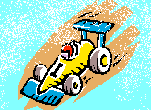
Topic 6: Stoichiometry
a) How much can a reaction produce?
Reactants can be produced by identities and relative amounts of the products and reactants. It is very useful to predict the exactly how much mass of a substance will be involved in a reaction. Such predictions are a part of Chemistry known as Stoichiometry. Stoichiometry is mass and quantity relationships among reactants and products in a chemical reaction.
The makers of artificial flavors for items such as banana ice cream or banana-flavored bubble gum need to use stoichiometry when they make the banana flavoring. The substance providing most of the taste and smell of bananas is actually a single compound known as 3-methylbutyl acetate, or isoamyl acetate.
When solving stoichiometry problems it is good to solve with moles and grams. Avogadro's number is used to find the numbers of moles. Sometimes you get problems with units of grams in it. That is another way a problem is given in stoichiometry problems.
b) How much does a reaction really produce?
Leftover reactants. Some assumptions were made: there was always enough of the other reactants so that none would be left over, and all reactions went to completion, producing only the products indicated in the equation. There were no competing reactions.
Reactants combine in specific whole-number ratios. Have you every been in a car that ran out of gas? The car needed both gas and oxygen from the air to run, so once the gas was gone, it wouldn't run, no matter how much oxygen was present.

There is a lot of oxygen (white fizzy thing) around the car but there is no gas so it is not running.
A similar limitation occurs in all chemical reactions. When a chemical reaction occurs, the reactants are not always present in amounts equal to their mole ratios. Excess reactant is the reactant that is not completely used up in a chemical reaction. A Limiting reactant is a reactant that is used up first and thus limits the amount of thus limits the amount of other reactants that can participate in a chemical reaction to make products.
Incomplete reactions. Measuring what a chemical reaction actually produces. Although equations tell you what should happen, they can't always tell you what will happen. For example, a reaction will stop once the limiting reactant has been used up, regardless of how much of the other reactants is present.
Sometimes reactions don't match equations in other ways. The amount expected from stoichiometry calculations is called the theoretical yield. But, in some cases, the actual yield, the amount of product actually created, is not what was expected-it can be much less than the theoretical yield.
c) How can stoichiometry be used?
Stoichiometry and cars. When you drive a car, you are depending on stoichiometry to keep you safe and make the car work efficiently with the smallest possible impact on the environment. Air-bag design depends on stoichiometric precision. Air bags are designed to protect occupants in a car from injuries during a high-speed front-end collision. When inflated they gently slow down the occupants of a car so that they do not strike the steering wheel, windshield, or instrument panel as hard as they would without the air bag. The air-bag designer makes certain that air bags do not under-inflate or over-inflate. Bags that under-inflate do not provide enough protection for the occupants, and bags that over-inflate can cause injury or ay even rupture, making them useless. To adequately protect occupants, air bags must full inflate within one-tenth of a second after impact. The systems that make an air bag work this quickly are the crash sensor, back up power supply, inflator, and air bag.
